For those familiar with German football, Thomas Tuchel is already somewhat of a household name. Tuchel started his senior coaching career at Mainz and thanks to his tactics built around fast, brave football, as well as his adaptable shapes, he began to make a name for himself. He managed Mainz to ninth and fifth place in the league in his first two seasons, and continued to overperform with his squad of players, steering them clear of relegation throughout his tenure and going down as the best Mainz manager in history according to points per game. Tuchel then famously succeeded Jürgen Klopp at Borussia Dortmund, where he managed to make Dortmund a competitive and tactically astute side once again. The German adapted his style to Borussia Dortmund, with the quality and profile of players now allowing him to switch to a more possession-oriented approach. Tuchel only won one trophy at Dortmund in the DFB Pokal, however he lifted Dortmund back into challengers on the domestic front and successfully took over from one of the most influential managers in German football history.
In his final season at Mainz, and his first full season in Dortmund, Tuchel came head to head against Pep Guardiola, who Tuchel described as “the best” at the time. Any match involving Guardiola tends to be an interesting tactical conundrum for the opposition coach, and Tuchel displayed several interesting tactical plans against Guardiola. Although he is yet to win a game against the Spaniard, his tactical set ups have often caused Guardiola problems, and the gulf in quality of squads has also had an effect. This tactical analysis will examine one specific match between Tuchel and Guardiola, analysing the tactical battle between the two and focusing primarily on the reasoning behind Tuchel’s choices in an unorthodox system.
The pentagon
The match in question we’ll look at it is the first meeting between the two, with Bayern recording a 4-1 victory over Mainz. The game though was certainly not easy for Bayern as the scoreline may suggest, as at half time Mainz led the game 1-0 thanks to a Shawn Parker goal, with Mainz having little possession and limiting Bayern Munich to virtually no chances. Bayern Munich improved in the second half and early mistakes by Mainz decided the game, but Tuchel’s tactics in the game clearly caused Guardiola and Bayern some problems.
The main tactical feature this game is remembered for is Tuchel’s use of a pentagon shape, with a narrow 5-4-1 formation used. We can see this shape below, with two holding midfielders sitting deeper while wingers tuck in and stay narrow. The lone striker could apply relaxed pressure to the centre backs situationally, and could also perform the role of cutting access to the Bayern Munich pivot using his cover shadow.

We can see a basic overview of the shape again here, with left winger Choupo Moting remaining narrow and now pushing higher to press towards the Bayern centre back. The right winger for Mainz comes very narrow and can cover a nearby Bayern pivot, and so the two deeper central midfielders can remain both deep and central, as they are not drawn out by movements by the Bayern midfield. This means that even if the ball is able to be played into this pentagon, the chances of the opposition getting it out cleanly are low.Bayern here have used Rafinha as an inverted full-back, with the Brazilian now acting as a central midfielder and therefore helping to potentially create an overload in the middle of the pitch.

We can see an example here where Bayern switch play quickly and are able to gain access to the half-space, with their inside forward pressured. The central midfielder, who was once covered by Parker’s cover shadow, is now open and within the pentagon. However, the far central midfielder makes a quick pressing run towards the free midfielder, and Mainz win the ball in a good area to counter attack from. This pentagon shape and its narrow nature means counter-attacks through the centre can be accessed more easily if the ball is won, as opposed to wingers pressing very wide and having to recover back into the middle.

Therefore when this central midfielder receives the ball, this is the situation he finds himself in. Johannes Geis (the far central midfielder) pressing across is a clever movement as it cuts off a switch across the pitch and it also increases central compactness as opposed to the near central midfielder pressing. Mainz are then in a good shape to counter attack, with attackers being in more central areas meaning if they receive the ball they have greater passing options.

Showing Bayern into wide areas, and keeping them there
The objective behind the press was to restrict the centre of the pitch and force Bayern into wide areas, where Mainz defended the half-space well thanks to the roles and responsibilities given to players. We can see an example of these roles and responsibilities here, with Choupo-Moting staying very narrow as a winger and looking to cut the passing option into a central midfielder or inverted full-back. Covering this zone obviously increases central coverage, however the main consequence of this is that it allows the central midfielder behind to be more zonally oriented around the half-space, rather than man oriented and pressing forward up to a central midfielder.

Bayern’s natural option from the image above then is to play wide, and Mainz are well prepared for this. We can see once the ball is shown wide, Mainz have double cover in the half-space, with a centre back and central midfielder in this area. They have a wing-back deep to press the Bayern winger, and due to their back five formation, any threat in behind can often be nullified with good shifting or through a good offside line- none of which Mainz had for Bayern’s second goal in the second half.

We can see a nice shape again to protect the inside lanes here. Bayern use a wider full-back here, and Mainz are sufficiently high enough to allow the wing-back to push higher to press against the full-back. As a result, the narrow winger doesn’t have to push across slowly to press the full-back, and instead he can remain in the half-space and look to press the pass back inside. The nearest central midfielder can move across, and because the winger is still pressing a central midfield option, the Mainz central midfielder isn’t engaged.

Choup Moting presses the central midfielder here, while Parker has came across to cut access centrally using his cover shadow. The far winger remains narrow, but can press the full-back once the ball has been switched. Furthermore, Bayern don’t have central midfield options immediately available in this area, so the Mainz winger can commit more to this wide press.

Mainz’s central midfielders (Baumgartlinger and Geis) then do an excellent job of shifting across to close space, and again, the use of a back five by Mainz allows them to have permanent occupation of the half-space from behind, and the central midfielders simply act as an extra piece of cover.
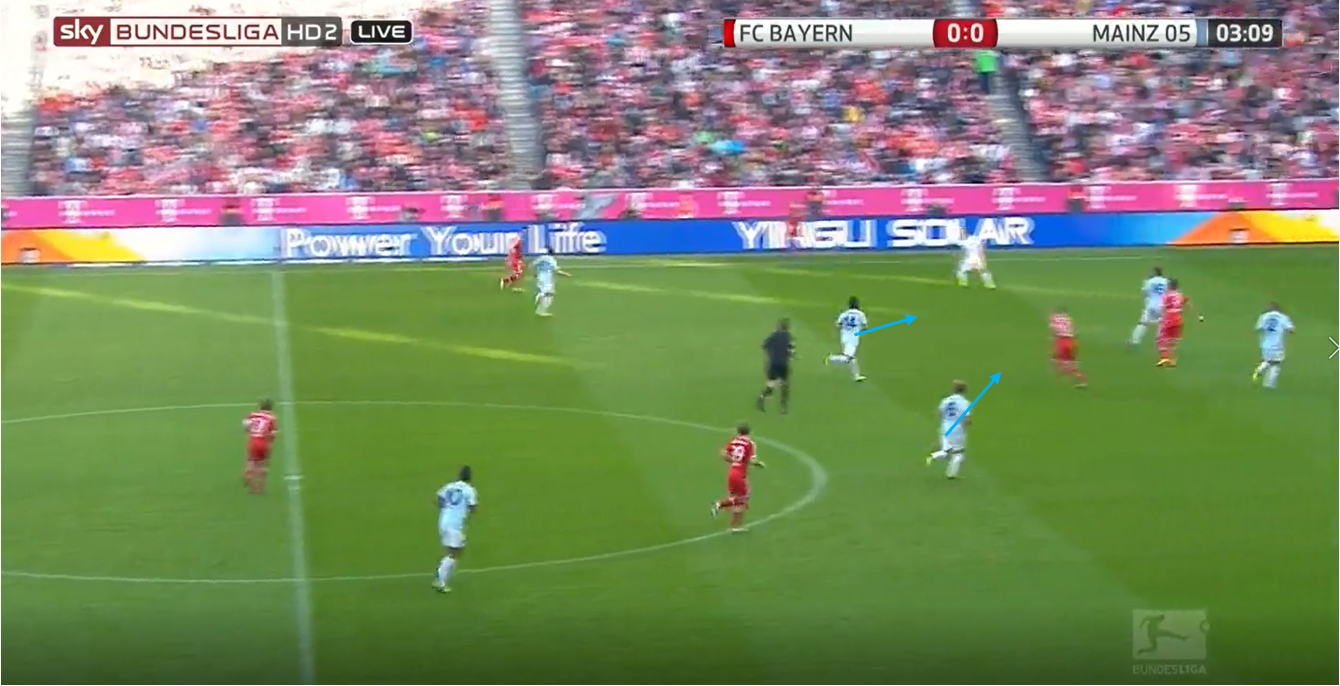
Bayern start to grow into the game
The obvious counter to any very compact side is switches in play or diagonal passes into far spaces, and Bayern exploited this more in the second half. Here, we see a nice response by the Mainz defender to this threat, with the player recognising this danger and pressing out early to prevent the pass being played. The nearest central midfielder covers the half-space, and the other midfielder has to shuffle across to keep compactness, and so the ball far space opens.

The same space opens again here, but the centre backs do a good job of pressing out to cover this space, and the overall compactness of the team makes it difficult to play through.

In the second half, Mainz became slightly more unstable with Bayern’s constant quick switches in play, and a mistake in pressing cost them the first Bayern goal just after half time, which made it difficult for Mainz. We can see the strange pressing error which cost them the first goal here, with Bayern dropping a player into the deeper area of the half-space as they had done all game. Neither the winger nor the near central midfielder cover this player, and so he is allowed to turn and play directly into the half-space. Mainz’s centre back can cover one option, but Bayern do a good job of overloading the half-space with a Arjen Robben running in behind to score.
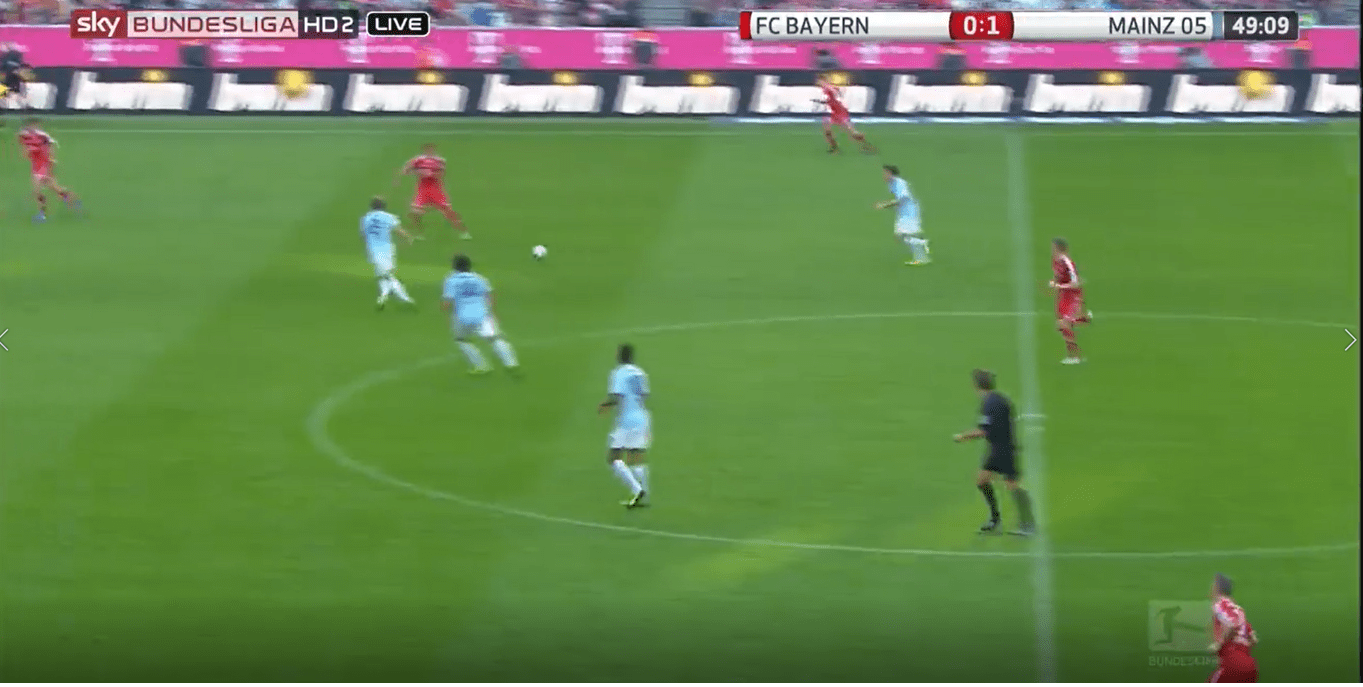
The common trend in the second half was Bayern doing a good job of forcing Mainz’s centre midfielders to be engaged higher, and so coverage of the half-space decreased. We can see the near central midfielder (circled) presses out, and so the centre back is alone in the half-space against two Bayern players. Mario Götze, who Guardiola brought on at half time for this reason, occupies the deeper area here and receives the ball, and is able to play a 1-2 to get behind the centre back. Bayern began to get better at progressing the ball down the line, and Guardiola’s signature cutback crosses resulted in Bayern running away with the game.
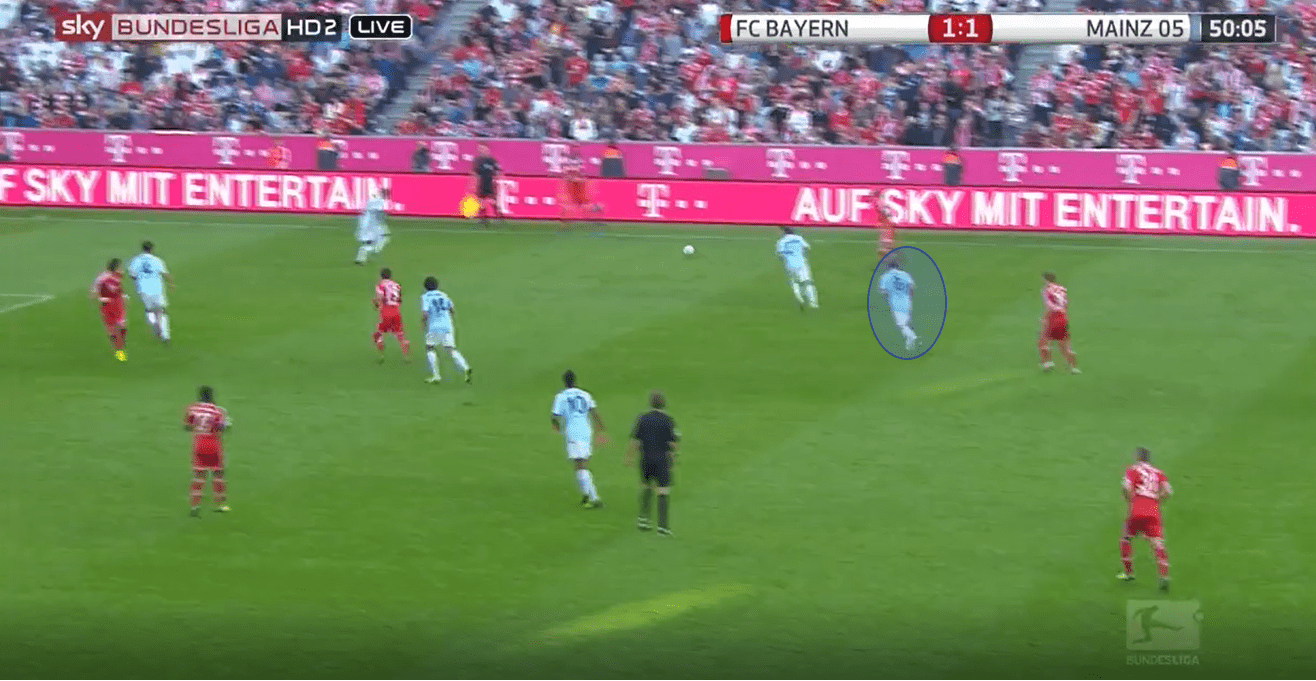
When Bayern dropped into a double width shape, they would look to overload the half-space with good movements in behind, and so the structure of the game could look like this at times. Mainz are set in their shape, with the near pivot covered narrowly by the winger, while the striker presses while covering the central area and/or a pivot. Deeper central midfielders can’t commit across too early (especially the ball near one) as this reduces central compactness, and so they stay narrow waiting for the ball to be played wide.
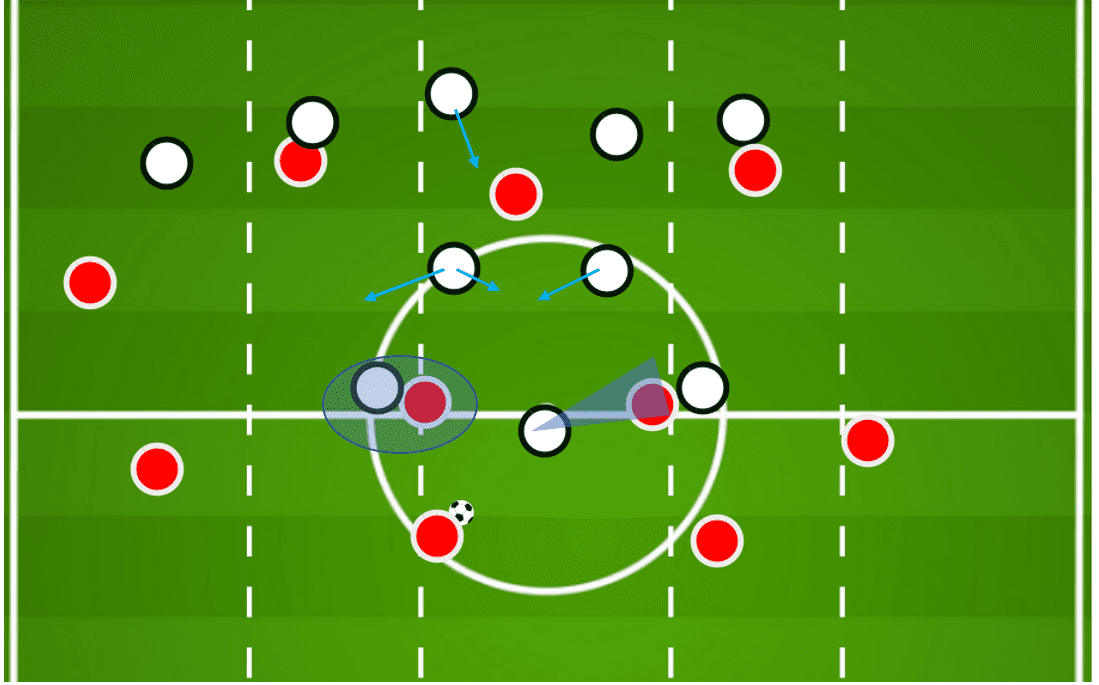
Once the ball is played wide, Mainz shift across and Bayern look to overload the half-space, if everyone does their job, the half-space coverage is maintained in a 2v2, and diagonal options into the centre can be just about cut off with good positioning. Centre backs can push out of the line to overcome midfield overloads, however when Bayern made these overloads deeper, the Mainz centre backs naturally wouldn’t want to press out too high. A switch to more coverage in midfield could therefore have maybe benefitted Mainz, as it would make shifting in the midfield line easier and nullify overloads. However, taking a man out of the back line would naturally reduce coverage in this back line, so the advantages of a back five in terms of shifting would be lost, meaning half-space overloads like the one seen below may be more accessible.
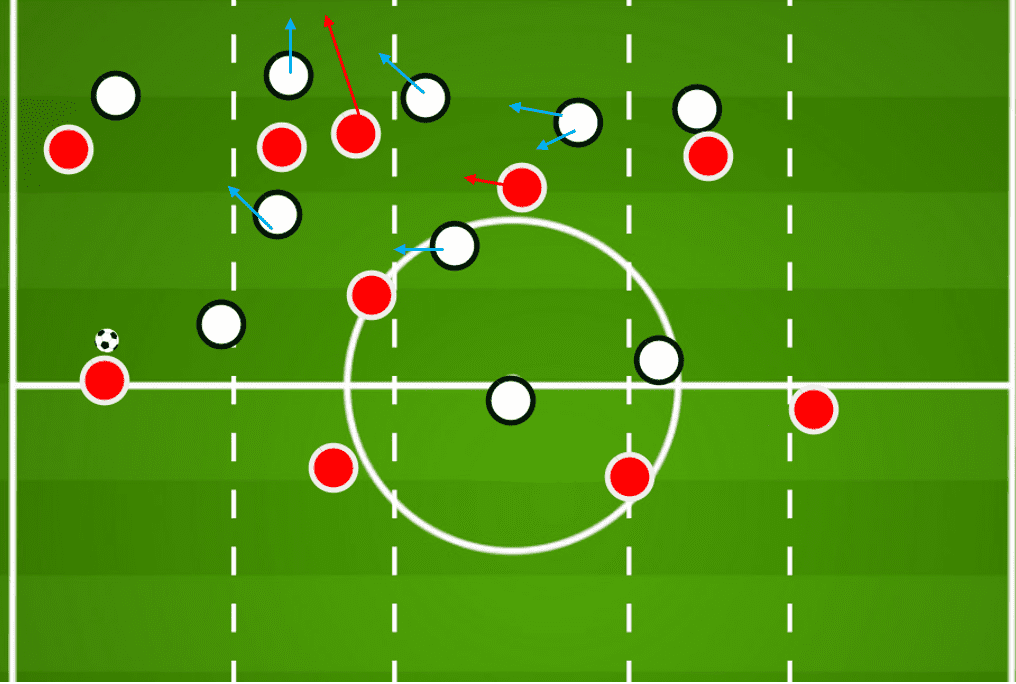
Here in the first half, Mainz get unbalanced momentarily, and a player is able to receive in the half-space and is effectively engaged in a 1v1 with the centre back, due to the near central midfielder being engaged forward. Bayern couldn’t access these areas in the first half very often at all, and even when they did, they weren’t prepared and were unable to create an overload. Tuchel’s side put up a good fight but their performance and pressing dropped off in the second half, leading to them being on the end of an undeserved 4-1 scoreline.
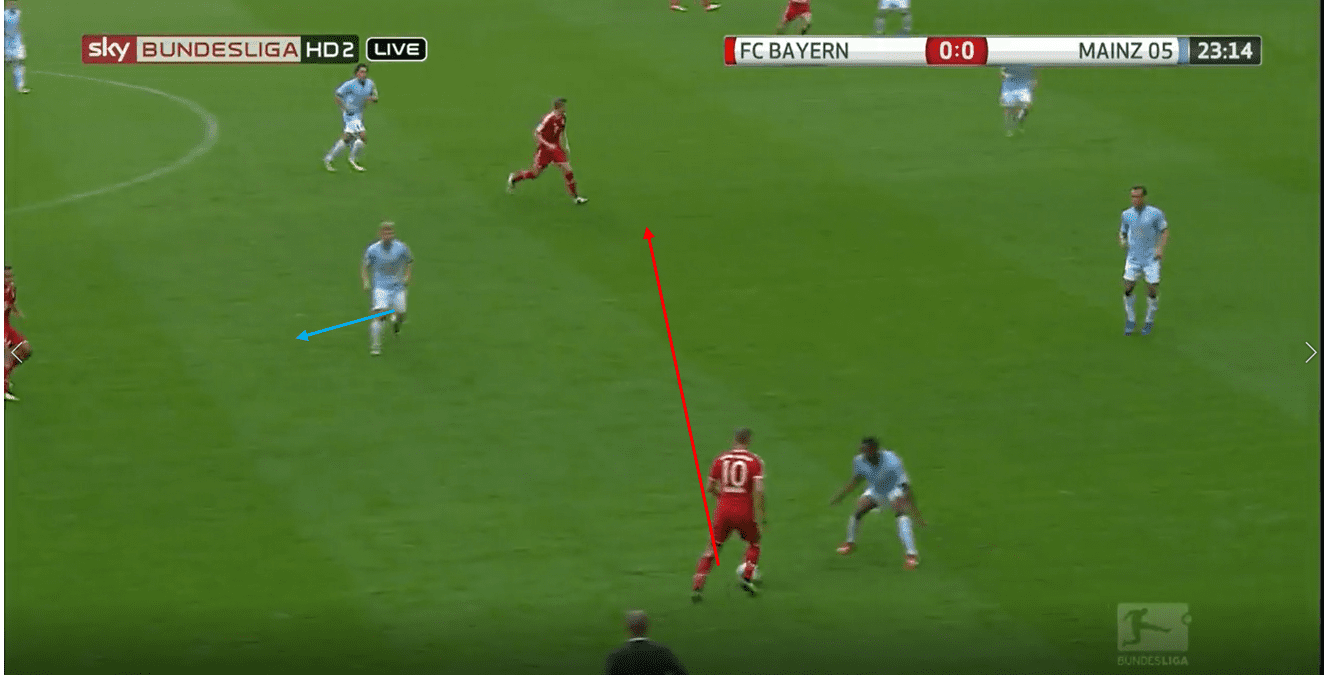
An alternative to moving to a back four to increase midfield coverage would be to rely on the forward line to sacrifice a player to nullify midfield overloads. We can see here the striker could back press against the Bayern pivot to cover this passing option, while the furthest winger would then look to tuck in slightly higher to give a better rest offense. Now, Mainz’s midfielders are not occupied forwards and so are not overloaded. This is however a big ask and simply cannot be performed consistently across 90 minutes, and so balancing this with their back five structure may have been a healthy compromise, but Mainz’s performance dropped off early in the second half.
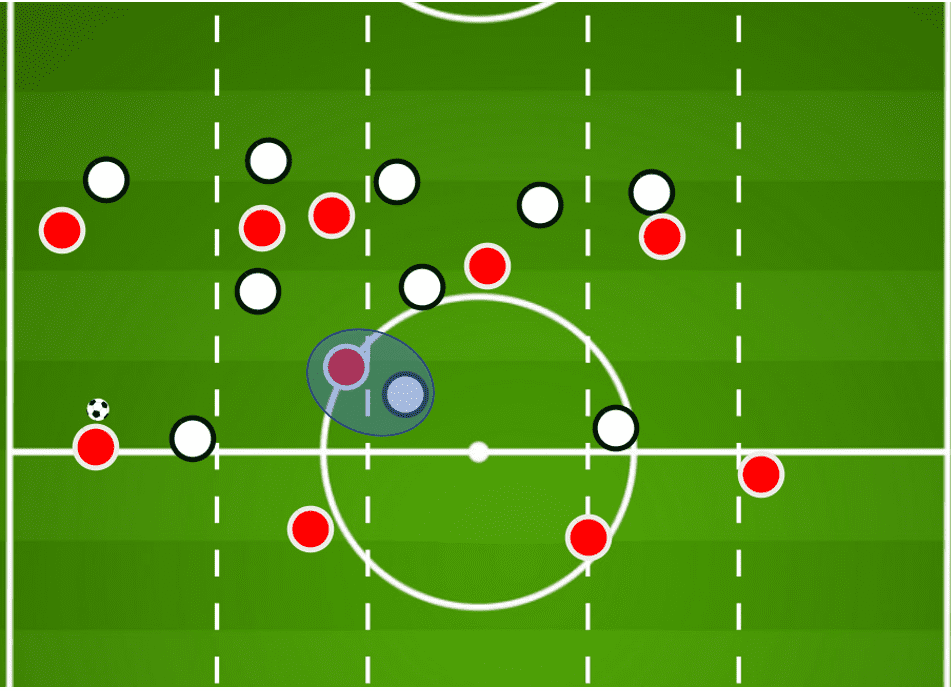
An alternative solution I have seen to this problem was showcased by Tuchel’s student turned rival Julian Nagelsmann, and I included this example in a recent piece on the RB Leipzig coach. Nagelsmann operated a very narrow 5-2-3 in this game, with Hoffenheim’s pivots covered by both inside forwards/wingers. As a result, if the ball went wide as it doesin this example below, both inside forwards would come across to the same side of the pitch. This was effective in limiting progression on one side of the pitch, but Hoffenheim’s switches in play caused Leipzig issues. Nevertheless, it is an interesting idea, particularly if the team you are facing is poor at switching the ball.
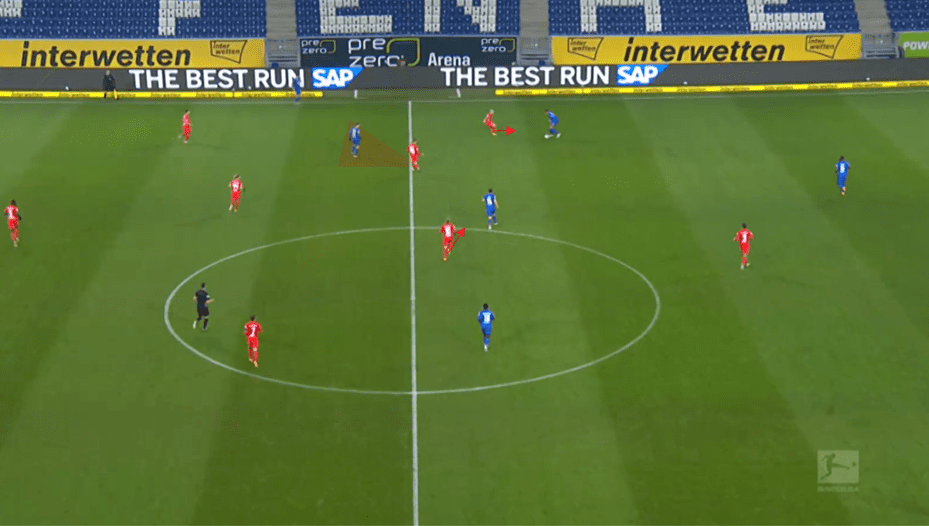
Conclusion
This analysis has looked at Tuchel’s first tactical battle against Pep Guardiola, specifically focusing on the German’s use of a narrow 5-4-1 formation and its dynamics against Guardiola’s positional play. Although the German lost the game 4-1, the game is a good example of Tuchel’s footballing brain and his tactical astuteness, something which I think will allow him to be successful if he is appointed Chelsea boss. As I mentioned, Tuchel’s playing style has adapted since Mainz, however Tuchel does still allow his team to sit deeper in a low block against positional play sides, with the Champions League final a good example of a clever low block pressing system being utilised by Tuchel. I plan to write more detailed analyses focused around Tuchel at all three of his clubs so far, and I would love to see him in the Premier League at some point, with the German’s tactical astuteness sure to add many more narratives to the Premier League season. The main question marks that seem to loom over Tuchel are his relationships with players and the board, but there are no doubting Tuchel’s footballing brain. Whether the German ends up at Chelsea or not, it will not be long until a top club comes calling for his signature. To answer the question posed in the title of this article then, unsurprisingly, yes I believe Tuchel is more than ready to manage in the Premier League.




Comments